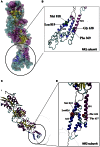Alcohol and NMDA receptor: current research and future direction
- PMID: 23754976
- PMCID: PMC3664776
- DOI: 10.3389/fnmol.2013.00014
Alcohol and NMDA receptor: current research and future direction
Abstract
The brain is one of the major targets of alcohol actions. Most of the excitatory synaptic transmission in the central nervous system is mediated by N-methyl-D-aspartate (NMDA) receptors. However, one of the most devastating effects of alcohol leads to brain shrinkage, loss of nerve cells at specific regions through a mechanism involving excitotoxicity, oxidative stress. Earlier studies have indicated that chronic exposure to ethanol both in vivo and in vitro, increases NR1 and NR2B gene expression and their polypeptide levels. The effect of alcohol and molecular changes on the regulatory process, which modulates NMDAR functions including factors altering transcription, translation, post-translational modifications, and protein expression, as well as those influencing their interactions with different regulatory proteins (downstream effectors) are incessantly increasing at the cellular level. Further, I discuss the various genetically altered mice approaches that have been used to study NMDA receptor subunits and their functional implication. In a recent countable review, epigenetic dimension (i.e., histone modification-induced chromatin remodeling and DNA methylation, in the process of alcohol related neuroadaptation) is one of the key molecular mechanisms in alcohol mediated NMDAR alteration. Here, I provide a recount on what has already been achieved, current trends and how the future research/studies of the NMDA receptor might lead to even greater engagement with many possible new insights into the neurobiology and treatment of alcoholism.
Keywords: NMDA receptor; RNA-binding protein; alcohol; epigenetic; fetal cortical neurons; glutamate; splice variant; transcription.
Figures










Similar articles
-
Alcohol related changes in regulation of NMDA receptor functions.Curr Neuropharmacol. 2008 Mar;6(1):39-54. doi: 10.2174/157015908783769662. Curr Neuropharmacol. 2008. PMID: 19305787 Free PMC article.
-
The NR2B subtype of NMDA receptor: a potential target for the treatment of alcohol dependence.Curr Drug Targets CNS Neurol Disord. 2004 Jun;3(3):169-79. doi: 10.2174/1568007043337409. Curr Drug Targets CNS Neurol Disord. 2004. PMID: 15180478 Review.
-
Role of altered structure and function of NMDA receptors in development of alcohol dependence.Curr Neuropharmacol. 2005 Oct;3(4):281-97. doi: 10.2174/157015905774322499. Curr Neuropharmacol. 2005. PMID: 18369402 Free PMC article.
-
Chronic ethanol exposure and protracted abstinence alter NMDA receptors in central amygdala.Neuropsychopharmacology. 2006 May;31(5):988-96. doi: 10.1038/sj.npp.1300840. Neuropsychopharmacology. 2006. PMID: 16052244
-
Glutamatergic transmission in opiate and alcohol dependence.Ann N Y Acad Sci. 2003 Nov;1003:196-211. doi: 10.1196/annals.1300.012. Ann N Y Acad Sci. 2003. PMID: 14684447 Review.
Cited by
-
Control of cortical neuronal migration by glutamate and GABA.Front Cell Neurosci. 2015 Jan 30;9:4. doi: 10.3389/fncel.2015.00004. eCollection 2015. Front Cell Neurosci. 2015. PMID: 25688185 Free PMC article. Review.
-
Effects of Consumption of Alcohol on Intraocular Pressure: Korea National Health and Nutrition Examination Survey 2010 to 2011.Nutrients. 2020 Aug 12;12(8):2420. doi: 10.3390/nu12082420. Nutrients. 2020. PMID: 32806703 Free PMC article.
-
NLRP3 deficiency decreases alcohol intake controlling anxiety-like behavior via modification of glutamatergic transmission in corticostriatal circuits.J Neuroinflammation. 2022 Dec 20;19(1):308. doi: 10.1186/s12974-022-02666-w. J Neuroinflammation. 2022. PMID: 36539796 Free PMC article.
-
Ethanol Enhances Estrogen Mediated Angiogenesis in Breast Cancer.J Cancer. 2018 Oct 6;9(21):3874-3885. doi: 10.7150/jca.25581. eCollection 2018. J Cancer. 2018. PMID: 30410590 Free PMC article.
-
Effects of ethanol on GluN1/GluN2A and GluN1/GluN2B NMDA receptor-ion channel gating kinetics.Alcohol Clin Exp Res. 2022 Dec;46(12):2203-2213. doi: 10.1111/acer.14965. Epub 2022 Nov 9. Alcohol Clin Exp Res. 2022. PMID: 36305341 Free PMC article.
References
-
- Acosta G., Hasenkamp W., Daunais J. B., Friedman D. P., Grant K. A., Hemby S. E. (2010). Ethanol self-administration modulation of NMDA receptor subunit and related synaptic protein mRNa expression in preforontal cortical fields in cynomolgus kineys. Brain Res. 1318, 144–154 10.1016/j.brainres.2009.12.050 - DOI - PMC - PubMed
-
- Alarcon J. M., Malleret G., Touzani K., Vronskaya S., Ishii S., Kandel E. R., et al. (2004). Chromatin acetylation, memory, and LTP are impaired in CBP−/− mice: a model for the cognitive deficit in Rubinstein-Taybi syndrome and its amelioration. Neuron 42, 947–959 10.1016/j.neuron.2004.05.021 - DOI - PubMed
LinkOut - more resources
Full Text Sources
Other Literature Sources

